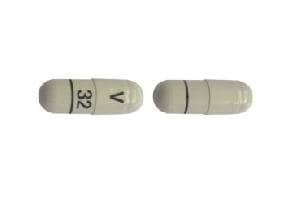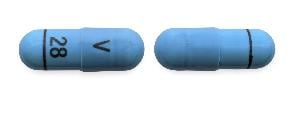Boxed Warning
Supine hypertension:
Monitor supine blood pressure prior to and during treatment and more frequently when increasing doses. Elevating the head of the bed lessens the risk of supine hypertension, and blood pressure should be measured in this position. If supine hypertension cannot be managed by elevation of the head of the bed, reduce or discontinue droxidopa.
Dosage Forms
Excipient information presented when available (limited, particularly for generics); consult specific product labeling.
Capsule, Oral:
Northera: 100 mg, 200 mg [contains fd&c blue #2 (indigotine)]
Northera: 300 mg [contains brilliant blue fcf (fd&c blue #1), corn starch, fd&c red #40, tartrazine (fd&c yellow #5)]
Pharmacology
Mechanism of Action
A synthetic amino acid analog that is directly metabolized to norepinephrine by dopadecarboxylase. Droxidopa is believed to exert its pharmacological effects through norepinephrine. Norepinephrine increases blood pressure by inducing peripheral arterial and venous vasoconstriction.
Pharmacokinetics/Pharmacodynamics
Absorption
High-fat meals reduce the Cmax and area under the plasma concentration-time curve (AUC) by 35% and 20%, respectively, and delay the Cmax by approximately 2 hours.
Distribution
Vd: ~200 L
Metabolism
The metabolism of droxidopa is mediated by catecholamine pathway. Droxidopa is initially converted to methoxylated dihydroxyphenylserine (3-OM-DOPS), a major metabolite, by catechol-O-methyltransferase (COMT), to norepinephrine by DOPA decarboxylase (DDC), or to protocatechualdehyde by DOPS aldolase.
Excretion
Urine (~75%)
Time to Peak
Plasma: 1 to 4 hours
Half-Life Elimination
~2.5 hours
Protein Binding
26% to 75%
Use: Labeled Indications
Neurogenic orthostatic hypotension: Treatment of orthostatic dizziness, light-headedness, or the “feeling that you are about to black out” in adults with symptomatic neurogenic orthostatic hypotension (NOH) caused by primary autonomic failure (Parkinson disease [PD], multiple system atrophy [MSA], and pure autonomic failure [PAF]), dopamine beta-hydroxylase deficiency, and nondiabetic autonomic neuropathy.
Contraindications
Hypersensitivity to droxidopa or any component of the formulation.
Dosage and Administration
Dosing: Adult
Neurogenic orthostatic hypotension: Oral: Initial: 100 mg 3 times daily; titrate in increments of 100 mg 3 times daily every 24 to 48 hours to symptomatic response (maximum dose: 1,800 mg/day).
Dosing: Geriatric
Refer to adult dosing.
Administration
Administer capsule whole, consistently with or without food, upon arising in the morning, at midday, and in the late afternoon at least 3 hours prior to bedtime (to reduce the potential for supine hypertension during sleep).
Storage
Store at 20°C to 25°C (68°F to 77°F); excursions permitted to 15°C to 30°C (59°F to 86°F)
Droxidopa Images
Drug Interactions
Amezinium: May enhance the adverse/toxic effect of Droxidopa. Monitor therapy
Carbidopa: May diminish the therapeutic effect of Droxidopa. Carbidopa may decrease serum concentrations of the active metabolite(s) of Droxidopa. Carbidopa may increase the serum concentration of Droxidopa. Monitor therapy
Ephedra: May enhance the hypertensive effect of Droxidopa. Monitor therapy
EPHEDrine (Systemic): May enhance the hypertensive effect of Droxidopa. Monitor therapy
Ifenprodil: May diminish the therapeutic effect of Droxidopa. Monitor therapy
Midodrine: May enhance the hypertensive effect of Droxidopa. Monitor therapy
Monoamine Oxidase Inhibitors: May enhance the hypertensive effect of Droxidopa. Exceptions: Rasagiline; Safinamide; Selegiline. Avoid combination
Norepinephrine: May enhance the hypertensive effect of Droxidopa. Monitor therapy
Serotonin 5-HT1D Receptor Agonists (Triptans): May enhance the hypertensive effect of Droxidopa. Monitor therapy
Adverse Reactions
>10%: Central nervous system: Headache (6% to 13%)
1% to 10%:
Cardiovascular: Hypertension (2% to 7%)
Central nervous system: Dizziness (4% to 10%)
Gastrointestinal: Nausea (9%)
Postmarketing and/or case reports: Abdominal pain, agitation, blurred vision, cerebrovascular accident, chest pain, confusion, delirium, diarrhea, fatigue, hallucination, hyperpyrexia, hypersensitivity reaction (including anaphylaxis, angioedema, bronchospasm, skin rash, urticaria), memory impairment, pancreatitis, psychosis, vomiting
Warnings/Precautions
Concerns related to adverse effects:
- Anaphylaxis/allergic reactions: Hypersensitivity reactions have been reported. Reactions may include anaphylaxis, angioedema, bronchospasm, rash, and urticaria; emergency treatment may be necessary. Discontinue use and initiate immediate medical support if a hypersensitivity reaction occurs.
- Hypertension: [US Boxed Warning]: Droxidopa may cause or exacerbate supine hypertension. Advise patients to elevate the head of bed when resting or sleeping. Monitor blood pressure in supine position and in recommended head-elevated sleeping position. Reduce or discontinue droxidopa if supine hypertension persists. Risk of cardiovascular events may be increased if supine hypertension is not well managed.
- Neuroleptic malignant syndrome: A symptom complex resembling neuroleptic malignant syndrome has been reported; symptoms have included hyperpyrexia and confusion. Observe patients carefully with dose changes or when concomitant levodopa is reduced abruptly or discontinued, especially if patient is receiving neuroleptics.
Disease-related concerns:
- Cardiovascular disease: Droxidopa may exacerbate existing ischemic heart disease, arrhythmias, and congestive heart failure; consider potential risk prior to initiating therapy.
Dosage form specific issues:
- Tartrazine: May contain FD+C Yellow No. 5 (tartrazine), which may cause allergic reactions, including bronchial asthma in susceptible individuals, especially in patients with aspirin hypersensitivity.
Monitoring Parameters
Monitor supine blood pressure prior to and during treatment and more frequently when increasing the dose.
Pregnancy
Pregnancy Considerations
Adverse events have been observed in some animal reproduction studies.
Patient Education
What is this drug used for?
- It is used to treat dizziness or the feeling that you are about to black out.
Frequently reported side effects of this drug
- Nausea
Other side effects of this drug: Talk with your doctor right away if you have any of these signs of:
- Abnormal heartbeat
- Shortness of breath
- Excessive weight gain
- Swelling of arms or legs
- Severe headache
- Severe dizziness
- Passing out
- Vision changes
- Falls
- Urinary tract infection like blood in urine, burning or painful urination, passing a lot of urine, fever, lower abdominal pain, or pelvic pain
- Severe cerebrovascular disease like change in strength on one side is greater than the other, difficulty speaking or thinking, change in balance, or vision changes
- Neuroleptic malignant syndrome like fever, muscle cramps or stiffness, dizziness, severe headache, confusion, change in thinking, fast heartbeat, abnormal heartbeat, or sweating a lot
- Signs of a significant reaction like wheezing; chest tightness; fever; itching; bad cough; blue skin color; seizures; or swelling of face, lips, tongue, or throat.
Note: This is not a comprehensive list of all side effects. Talk to your doctor if you have questions.
Consumer Information Use and Disclaimer: This information should not be used to decide whether or not to take this medicine or any other medicine. Only the healthcare provider has the knowledge and training to decide which medicines are right for a specific patient. This information does not endorse any medicine as safe, effective, or approved for treating any patient or health condition. This is only a brief summary of general information about this medicine. It does NOT include all information about the possible uses, directions, warnings, precautions, interactions, adverse effects, or risks that may apply to this medicine. This information is not specific medical advice and does not replace information you receive from the healthcare provider. You must talk with the healthcare provider for complete information about the risks and benefits of using this medicine.






